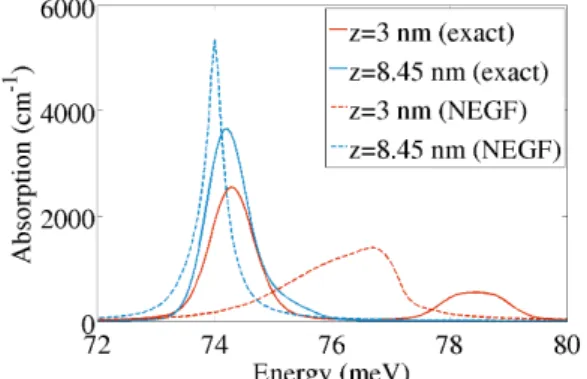HAL Id: hal-00918355
https://hal.archives-ouvertes.fr/hal-00918355
Submitted on 13 Dec 2013HAL is a multi-disciplinary open access
archive for the deposit and dissemination of sci-entific research documents, whether they are pub-lished or not. The documents may come from teaching and research institutions in France or abroad, or from public or private research centers.
L’archive ouverte pluridisciplinaire HAL, est destinée au dépôt et à la diffusion de documents scientifiques de niveau recherche, publiés ou non, émanant des établissements d’enseignement et de recherche français ou étrangers, des laboratoires publics ou privés.
Optical quasi-selection rules in imperfect
two-dimensional heterostructures
Camille Ndebeka-Bandou, Francesca Carosella, Robson Ferreira, Andreas
Wacker, Gérald Bastard
To cite this version:
Camille Ndebeka-Bandou, Francesca Carosella, Robson Ferreira, Andreas Wacker, Gérald Bastard. Optical quasi-selection rules in imperfect two-dimensional heterostructures. 18th International Con-ference on Electron Dynamics in Semiconductors, Optoelectronics and Nanos- tructures, Jul 2013, Matsue, Japan. �hal-00918355�
Optical quasi-selection rules in imperfect two-dimensional heterostructures C. Ndebeka-Bandou1 , F. Carosella1 , R. Ferreira1 , A. Wacker2 and G. Bastard1,3 1
Laboratoire Pierre Aigrain, Ecole Normale Sup´erieure, 24 rue Lhomond F-75005 Paris, France 2
Mathematical Physics, Lund University, Box 118, S-22100 Lund, Sweden 3
Technical University Vienna, Photonics Institute, Gusshausstrasse 27, A-1040 Vienna, Austria camille.ndebeka-bandou@lpa.ens.fr
Quantum Cascade Lasers are coherent sources based on quantum confinement and tunneling in semicon-ductor heterostructures. They are unipolar devices where the lasing action takes place between two conduction subbands of biased multi-quantum well structure. These innovative devices are promising photonic sources especially because they allow an emission in the THz range. Nevertheless there are loss mechanisms that limit their performances and the research for improved structures is pursued worldwide.
Free Carrier Absorption (FCA) is a plausible source of losses for far-IR and THz lasers. It consists in the reabsorption of the laser photons by the free carriers, in particular those that occupy the upper laser subband.
Fig. 1. Absorption spectrum for a GaAs/AlGaAs DQW in presence of ionized impurities calculated by exact diagonalization (continuous line) and NEGF methods (dotted lines) using Born approximation. The impurity plane is placed in the left hand side well of the DQW at z=3 nm and z=8.45 nm. T=100K.
FCA arise from intra-subband and inter-subband oblique transitions (in the~k space) activated by static scatterers or phonons. Tayloring FCA requires to deeply understand the nature of the optical transitions in imperfect structures.
We have solved numerically the Schr¨odinger equation by an exact diagonalization for a GaAs/AlGaAs double quantum well (DQW) structure in presence of ionized impu-rities. These static scatterers are randomly placed on a plane located either in the wells or in the barrier of the DQW. The results of the calculation show that ionized impurities change dramatically the nature of the energy spectrum by creating bound states below the subband edges [1]. Never-theless we have found that the effect of the impurity poten-tial on the absorption spectrum can be tailored by adjusting the position of the impurity plane with respect to the het-erostructure wave functions. This result is shown in Fig. 1 which displays the calculated absorption spectrum (contin-uous lines) for two different doping positions. Note that one
impurity peak has disappeared when z=8.45 nm. For comparison the absorption spectrum was also calculated by the nonequilibrium Green’s function (NEGF) approach [2], which takes into account scattering within the self-consistent Born approximation (dotted lines). While this approximation does not provide the effects of bound states, the general trend regarding the position dependence of the linewidth is reproduced.
In the present work, we will present the results of a detailed analysis of the nature of the optical transitions and point out the existence of efficient optical quasi-selection rules in disordered structures, with a specific attention to the case of ionized impurities. These calculations allow to better understand the FCA spectrum shape and to quantitatively assess its magnitude in cascade structures. Finally, we will compare the results obtained by exact diagonalization and by NEGF method and we will discuss their differences and domains of applicability.
References
[1] D. Stehr, C. Metzner, M. Helm, T. Roch and G. Strasser, Phys. Rev. Lett. 95, 257401 (2005).
